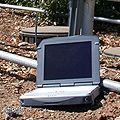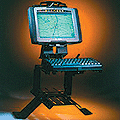|
GETAC B300
Getac's fully rugged notebook computer gets a major technology upgrade
(by Conrad H. Blickenstorfer -- photography by Carol Cotton -- view PDF version))
Update July 28, 2011: Getac announced that the rugged B300 notebook computer was improved once again, this time with a switch from a 45nm Intel 2GHz i7-620LM to a 32nm 2.3GHz i7-2649M processor. The new chip not only has a faster overall clock speed, its system bus is twice as fast, graphics frequency has doubled as well, and the chip can use faster memory. The upgrade also includes three USB 3.0 ports (two doubling as eSATA ports), even longer battery life (up to 30 hours with the dual battery option!), and standard -20F low operating temperature. 4G mobile broadband technology will be available beginning in Q4. Getac claims a 25% performance boost.
The Getac B300 was first introduced in early 2008 to fill the need for a compact, fully rugged notebook computer with long battery life and a display that was bright enough to be read in full sunlight. The B300 was also created to take on its main rivals, which at the time were the GD-Itronix XR-1 and the Panasonic CF-30. We reviewed the B300 and found it to be a superb and cleverly designed rugged machine that was well equipped to take on the established competition.
Time and the competition move on, however, and so in September 2010, Getac announced a substantial technology, feature, and ruggedness update to the B300. On the technology side, the new version was upgraded to a more powerful Intel Core i7 processor, more and faster RAM, larger hard disks and the availability of optional SSDs, an optional display that is even brighter than before (1400 nits!), better sealing and a wider operating temperature range, faster and more extensive wireless communication support, as well as faster graphics and an HDMI port. In this report we're taking a closer look at the updated Getac B300 and what it has to offer.

Getac B300 positioning
When it comes to building mobile computers that can stand up to more abuse than standard commercial equipment, there are several ways to go. If cost is no object you can build a veritable fortress of a laptop, designed to survive the most severe conditions imaginable. If cost is an object, you may go with a toughened-up version of a commercial product. The sweet spot, however, is somewhere between ultra-rugged and semi-rugged—machines that offer all the features and performance of a standard commercial notebook computer, yet are able to absorb the kind of abuse they may encounter on tough jobs in the field, in vehicles, and even on the frontline. And as if meeting those requirements were not difficult enough already, the machines must also be reasonably compact and light. And their batteries must last longer since they cannot always be plugged in.
When you look at the market for standard-size rugged notebook computers, it's primarily a race between offerings from Panasonic, Getac, and GD-Itronix. Dell has ruggedized versions of some of its commercial notebooks, and there are some Taiwan-based OEMs that have been making inroads. Getac, however, is definitely one of the major players, and it's probably fair to say that Panasonic and GD-Itronix are their major competition.
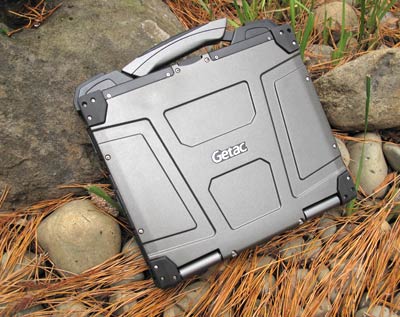 In terms of dimensions, weight and display size, rugged notebooks in this class have 13.3-inch displays with the old 4:3 aspect ratio, and they weigh around eight pounds. The B300 has a footprint of 11.9 x 10.3 inches (the substantial magnesium handle with a group of indicator lights in its base adds another inch and a quarter), and our review machine weighed in at 8.6 pounds, including handle and battery. The B300 is also about 2.4 inches thick, so this is no ultra-thin or lightweight. Size and weight, however, are about standard in this class. You don't slip a computer like the B300 into a briefcase, but this fully rugged warrior is really only a couple of pounds heavier than today's commercial full-size wide-screen notebooks. In terms of dimensions, weight and display size, rugged notebooks in this class have 13.3-inch displays with the old 4:3 aspect ratio, and they weigh around eight pounds. The B300 has a footprint of 11.9 x 10.3 inches (the substantial magnesium handle with a group of indicator lights in its base adds another inch and a quarter), and our review machine weighed in at 8.6 pounds, including handle and battery. The B300 is also about 2.4 inches thick, so this is no ultra-thin or lightweight. Size and weight, however, are about standard in this class. You don't slip a computer like the B300 into a briefcase, but this fully rugged warrior is really only a couple of pounds heavier than today's commercial full-size wide-screen notebooks.
Rugged notebook computers in this class ae also expected to have enough performance to run almost any application well, a display bright enough to be used out in the sun, a multimedia bay for an optical drive or a second battery or hard drive, cover all the bases in wireless communication, and have enough onboard connectivity to hook up to almost anything. There must also be a full-size keyboard, sealing good enough to handle dust and rain, enough ruggedness to survive a drop and getting bumped around in a vehicle, and a warranty that lets you sleep at night. The Getac B300 delivers in all these areas.
Design and construction
The design of the magnesium-alloy housing of the Getac B300 with its matte black and gun-metal gray color scheme is timeless, elegant and tough. It combines pleasing industrial design with a lot of mechanical-looking details that give the computer a purposeful no-nonsense look. The message is that the B300 is a tool for tough jobs, but a rather attractive one. Below you can see the unit from the top and all four sides:
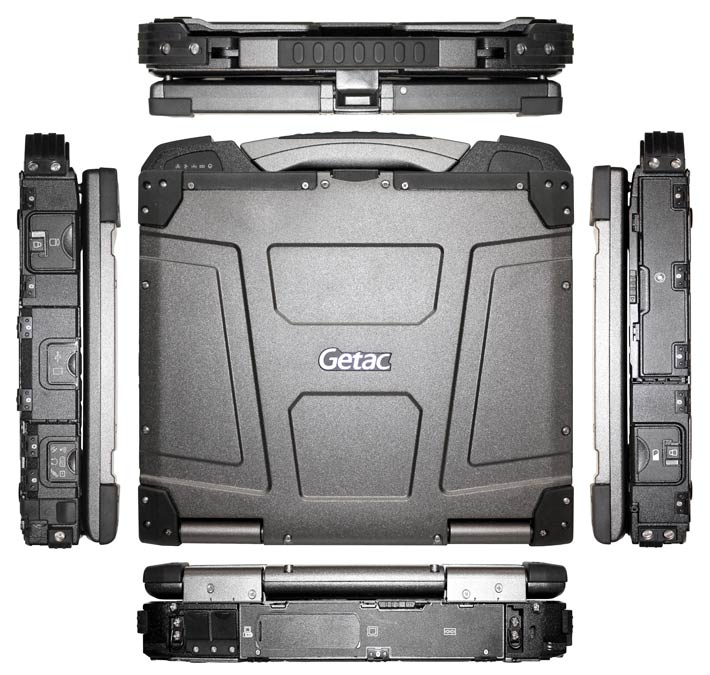
When they originally designed this fanless machine, Getac engineers faced the challenge of dissipating the heat of a fairly powerful processor. They did this by using a total of almost three feet of copper heatpiping that removed the heat generated by the primary chips. Amazingly, despite switching to a faster chip with a 50% higher thermal design power (25 ves 17 watts), Getac managed to stay with a fanless design, and how they did it becomes obvious once you remove the inside of the bottom cover. It uses the same thermal engineering principles as used in the original B300: heat spreader plates press against the CPU and chipset via thermally conductive material, the heat spreader plates connect to copper heat pipes, and the copper heat pipes are secured to the Magnesium alloy backplate. While the overall thermal design method remains the same, heat is spread (and dissipated) much more efficiently by expanding copper heat piping by about 50%; the B300 uses about 48 inches of copper heat piping versus only about 32 inches in the older unit. Outside, a sheet of thin, hard plastic is glued onto the surface, either to provide additional protection against scratching, or to make for a cooler touch when held in your hands.
Below you can see the original B300's thermal design solution (left), and the significantly beefed-up solution of the new B300 (right) that allows operating a 2GHz Core i7 processor without fan.
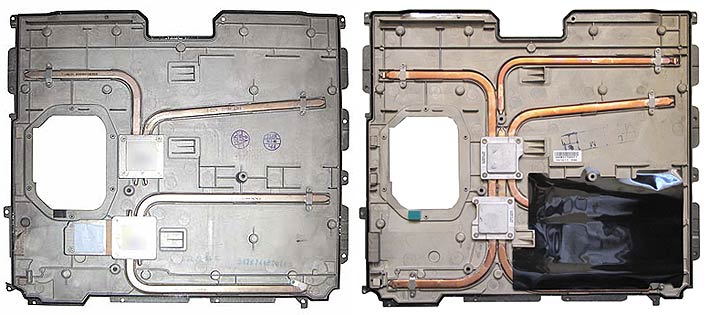
The bottom of the unit consists of a contoured magnesium alloy plate with a continuous O-right style seal along the entire perimeter. It is held securely in place by 18 small Philips screws (they come in two different sizes and some have washers whereas others do not). The whole assembly has an industrial high-tech look that always differentiates Getac machines.
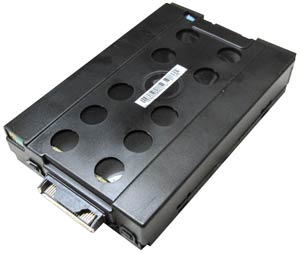 The sole door in the bottom plate has eight rounded corner -- no mere rectangles here -- and is also neatly and precisely sealed via foam pressing against an o-ring-style metal lip. The door is secured with six small Philips screws and provides access to the unit's two SO-DIMM slots (in our unit populated by two 2GB PC3/1066 modules). The sole door in the bottom plate has eight rounded corner -- no mere rectangles here -- and is also neatly and precisely sealed via foam pressing against an o-ring-style metal lip. The door is secured with six small Philips screws and provides access to the unit's two SO-DIMM slots (in our unit populated by two 2GB PC3/1066 modules).
The hard disk caddy (see image to the right) is a remarkably intricate affair consisting of a metal outer housing heavily padded with different types of foam and neoprene. What appears to be a heating element is wrapped around the disk (a Toshiba MK2565GSX in our unit). The optical drive in our unit was a Sony Optiarc AD-7580S DVD/CD rewritable drive (see specs).
The battery is a powerful 11.1 Volt/7,8000mAH 87 watt-hour unit with a built-in battery gauge that shows charge status via five green lights upon pressing the button next to it. You can't see the charge meter when the battery is installed in the unit, but it comes in handy when you carry spare batteries around. The battery can be removed if the unit is plugged in, but it is not hot-swappable.
As a full-size rugged notebook, the B300 comes with a full complement of ports, all of which are protected either by rubber plugs or hinged doors. The pictures below right show the left and the right side of the B300, both with the doors open and closed.
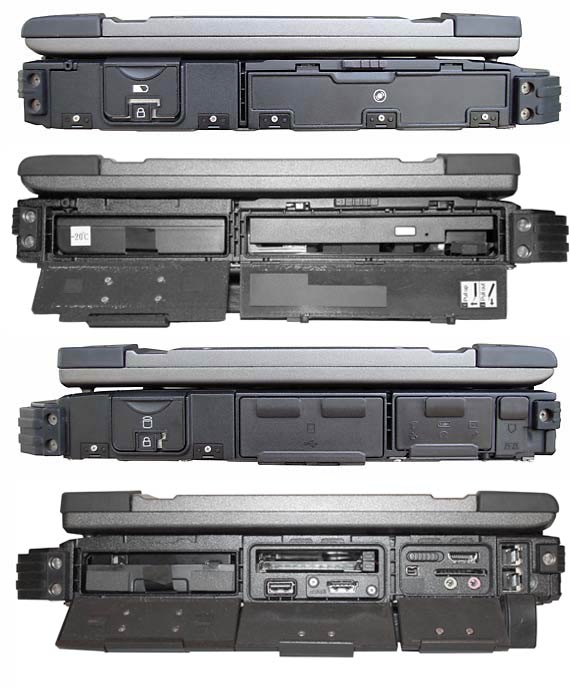 On the left side of the unit are the Media Bay and access to the main battery. The Media Bay is protected by a hinged door that snaps closed when two hooks engage. A spring-loaded lever releases the hooks. The door seals tightly when closed. The battery compartment has a double-locking mechanism. First you move a small lever to unlock the main lever. Then you move a larger lever to fully release the door. Both levers go hard and it is unlikely that they'll ever open by accident.
On the left side of the unit are the Media Bay and access to the main battery. The Media Bay is protected by a hinged door that snaps closed when two hooks engage. A spring-loaded lever releases the hooks. The door seals tightly when closed. The battery compartment has a double-locking mechanism. First you move a small lever to unlock the main lever. Then you move a larger lever to fully release the door. Both levers go hard and it is unlikely that they'll ever open by accident.
On the right side you find access to the hard disk, expansion ports, and a variety of other ports. The hard disk caddy sits behind a double-lock door like the one used for the battery on the other side. The door closes and seals securely, but it cannot be locked, and thus provides potentially unwanted access to the hard disk. On the other hand, military and other customers often require the ability to quickly and easily remove the hard disk. A hinged plastic door with a rubber pressure seal protects the stacked PC Card Type II and ExpressCard 34/54 slots and two USB 2.0 ports, one of which is of the combination USB/eSata variety. A compartment next to it has separate microphone and headphone jacks, a IEEE1394 "FireWire" port, an HDMI port (new), a springloaded SD card slot, and an (unmarked) RF switch that turns all installed radios on or off. Next to that is yet another door that protects and seals the RJ-45 gigabit LAN jack as well an the RJ11 landline jack for those who still use modems.
Along the backside of the B300, which is unchanged compared to the original design, are the individually sealed power jack and an also individually sealed third USB 2.0 port. The better part of the backside is taken up by a large hinged door that covers two 9-pin DB9 serial ports and a 25-pin video port. The cover has an integrated sliding door that provides access to the expansion bus connector even while the main door is closed. On the right side is a Kensington lock slot, and there are two D-rings for a carry strap.
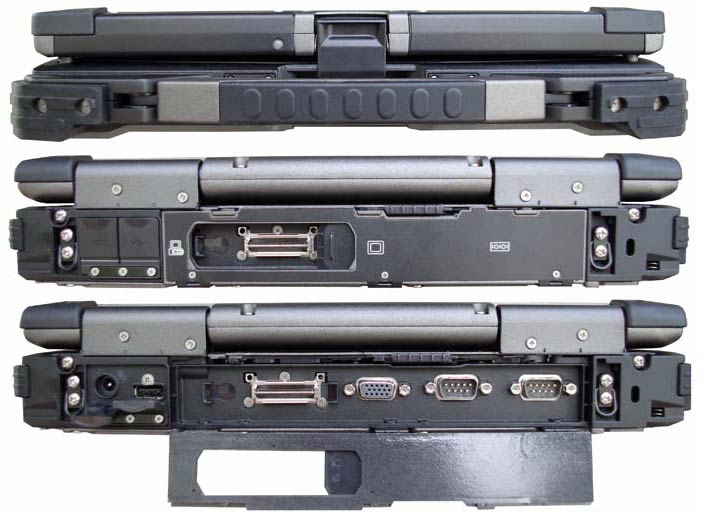
Most of the doors have metal hinges that are screwed onto the body and the actual door via two Philips screws each, making replacements very easy.
The front of the unit does not have any connectors or ports other than two small speakers to the left and right of the LCD case clasp. There wouldn't be room for anything else as most of the front is taken up the large, impressive looking magnesium handle that is screwed onto the system side of the computer. There are, however, five indicator lights built into the right side of the handle base. They show the status of power, battery, WiFi, Bluetooth and GPS.
The B300's 89-key keyboard is full-scale. It has black keys with white labels. Instead of using less legible blue for function key combos, Getac used white for those labels also, but placed them in little white square boxes.
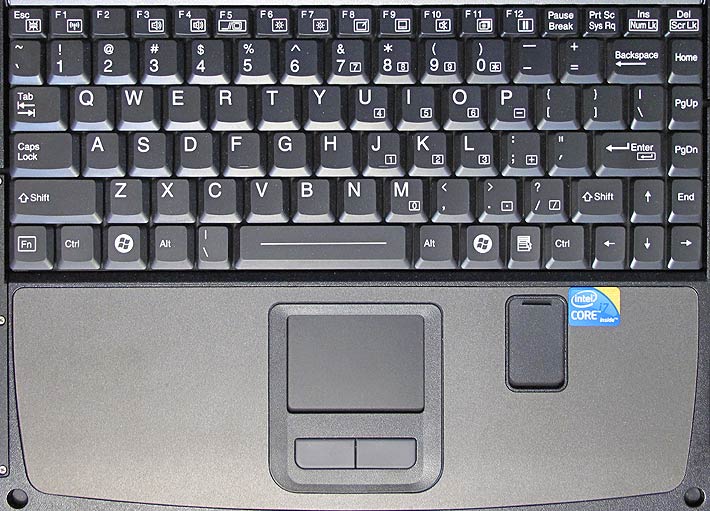
Below the keyboard is a small and slightly recessed (so you can feel its boundaries in the dark) touchpad and two mouse buttons. The touchpad is on the smallish side, but it's much more responsive than the one on its arch nemesis, the Panasonic 31. To the right is a fingerprint reader that has its own sliding door.
The keyboard has a red backlight that can be set to come on automatically. It's pleasant and clearly illuminates the keys in semi and full darkness. One potential problem is that when viewed from an angle, the red illumination peeking out between keys can overwhelm the actual illumination of the key.

Above the keyboard are five hardware pushbuttons. From left to right, they are:
- Power
- P1 function button (turned display on and off on our unit)
- ECO button for engaging power conservation mode under battery power
- High-Bright button (turns display to full 1,400 nit power)
- Light sensor (engages light sensor adjustment of display brightness)

Having hardware buttons to turn quickly off the display and make it super-bright comes in very handy. It's much quicker than fumbling with menus. On the other hand, we wish the power button were elsewhere, as we often inadvertantly pushed it, sending the unit to sleep.
Performance
We do not envy the product planners and engineers who must decide what level of performance to bestow upon a rugged notebook. While high performance is always good, it means either a larger battery or less battery life, and it means more heat, which may make a fan necessary. Lower performance means longer battery life and less heat, but then the machine may be considered to be too slow. The challenge then becomes to find a happy medium and balance between performance, size, weight, battery life and heat generation. So how did Getac handle this difficult but strategically important decision?
 They moved up the performance ladder, but without going all out and incurring high performance related penalties. The step up from the original 1.6GHz Intel Core 2 Duo L7500 to the 2.0GHz Intel Core i7-620LM is substantial, especially since the new chip can operate at up to 2.8GHz in turbo mode (Intel's turbo mode allows the chip to incrementally overclock itself if certain conditions are met). The picture to the right shows the guts of the Intel Core i7 processor with its integrated graphics core and compansion chip. Rival Panasonic faced the same issue when evolving their Toughbook 30 to the latest Toughbook 31 model. They moved from a 1.6GHz Intel Core 2 Duo SL9300 all the way up to a 2.53GHz Intel Core i5-540M, a standard voltage chip with a substantial TDP of 35 watt. This necessitated a fan for the latest Panasonic while, with the low voltage 620LM processor, Getac still managed to run the machine without a fan. They moved up the performance ladder, but without going all out and incurring high performance related penalties. The step up from the original 1.6GHz Intel Core 2 Duo L7500 to the 2.0GHz Intel Core i7-620LM is substantial, especially since the new chip can operate at up to 2.8GHz in turbo mode (Intel's turbo mode allows the chip to incrementally overclock itself if certain conditions are met). The picture to the right shows the guts of the Intel Core i7 processor with its integrated graphics core and compansion chip. Rival Panasonic faced the same issue when evolving their Toughbook 30 to the latest Toughbook 31 model. They moved from a 1.6GHz Intel Core 2 Duo SL9300 all the way up to a 2.53GHz Intel Core i5-540M, a standard voltage chip with a substantial TDP of 35 watt. This necessitated a fan for the latest Panasonic while, with the low voltage 620LM processor, Getac still managed to run the machine without a fan.
In order to get a sense of where the B300's performance level stands compared to its predecessor and its major competitors, we installed Passmark Software's PerformanceTest 6.1 that runs about 30 tests covering CPU, 2D graphics, 3D graphics, memory, and disk and then computes scores for each category and an overall PassMark score. We also ran our second benchmark suite, CrystalMark. The results are below, and for comparison we added the original B300, the latest Panasonic 31, as well as three GD-Itronix units that also compete in or near this class.
Below are the results:
|
PERFORMANCE COMPARISON
|
Getac
|
Getac
|
Panasonic
|
Panasonic
|
GD-Itronix
|
GD-Itronix
|
GD-Itronix
|
|
Model
|
B300X
|
B300
|
31 (Intel graphics)
|
31 (ATI graphics)
|
GD8000
|
GD6000
|
Topaz
|
|
Processor
|
Intel Core i7-620LM
|
Intel Core 2 Duo L7500
|
Intel Core i5M540M
|
Intel Core i5-540M
|
Intel Core 2 Duo SL9400
|
Intel Core 2 Duo T9400
|
Intel Core 2 Duo T9400
|
|
CPU Speed
|
2.00/2.80GHz
|
1.60GHz
|
2.53/3.07GHz
|
2.53/3.07GHz
|
1.86GHz
|
2.53GHz
|
2.53GHz
|
|
Thermal Design Power (TDP)
|
25.0 watts
|
17.0 watts
|
35.0 watts
|
35.0 watts
|
17.0 watts
|
35.0 watts
|
35.0 watts
|
|
CPU Mark
|
926.6
|
893.9
|
1008.8
|
997.3
|
1185.5
|
1538.8
|
1636.4
|
|
2D Graphics Mark
|
258.3
|
158.5
|
249.6
|
263.1
|
102.1
|
294.8
|
447.6
|
|
Memory Mark
|
629.5
|
400.0
|
737.7
|
727.0
|
559.0
|
696.8
|
668.9
|
|
Disk Mark
|
575.1
|
343.3
|
589.1
|
590.4
|
372.6
|
378.0
|
615.8
|
|
3D Graphics Mark
|
272.7
|
138.3
|
352.3
|
487.5
|
52.7
|
180.7
|
238.8
|
|
Overall PassMark
|
547.4
|
420.8
|
600.2
|
613.5
|
518.8
|
679.5
|
776.7
|
|
ALU
|
26187
|
14320
|
34170
|
34258
|
18527
|
24808
|
25006
|
|
FPU
|
25170
|
16990
|
37566
|
37321
|
19617
|
26781
|
24109
|
|
MEM
|
21810
|
10148
|
24259
|
24657
|
14381
|
16651
|
15151
|
|
HDD
|
8668
|
6711
|
8629
|
8950
|
7109
|
6920
|
18135
|
|
GDI
|
8560
|
2565
|
5910
|
6300
|
6947
|
7966
|
9783
|
|
D2D
|
1819
|
4535
|
5656
|
1530
|
3100
|
3566
|
5798
|
|
OGL
|
2208
|
1020
|
2701
|
11318
|
1552
|
1936
|
23723
|
|
Overall CrystalMark
|
94422
|
56289
|
118891
|
124334
|
71233
|
88628
|
121705
|
As you can see, Getac's processor decision worked out well. Compared to the predecessor version, overall performance is up by 30% in one benchmark suite (PassMark) and by 67% in the other (CrystalMark). That is a substantial and very noticeable difference. The B300 doesn't quite reach the benchmark results of the Panasonic 31 with its standard voltage processor and higher clock speed, but the difference is not very large and Panasonic got the edge at the expense of having to use a fan. The included GD-Itronix models still used low and standard voltage Core 2 Duo processors. The B300 benchmarked ahead of its most direct GD-Itronix competitor (the GD8000), about on par with the vehicle-oriented GD6000, and behind the no-holds-barred Topaz with its dedicated nVidia graphics and much higher cost.
Note: if maximum speed is required, the manual suggests availability of a B300 version with the Intel Core i7-640LM that runs at a slightly faster 2.13GHz and reaches 2.93GHz in turbo mode.
Power draw and battery life
What does all of this newly enhanced performance mean for the new B300's battery life? The competition has set the bar pretty high in this class, with the Panasonic 31 and the GD-Itronix GD8000 both reaching over eight hours of theoretical battery life in our tests. The first generation B300, too, was a power-mizer and managed to reach a theoretical maximum battery life of almost 12 hours.
Running our standard BatteryMon benchmark with the B300 in ECO mode (radios off, LCD lowest, etc.) we recorded a power draw of as little as 8.9 watts, and generally in the 9 to 10 watt range. We then set the B300 to high-performance mode and the display to normal brightness. This increased power draw to 17 watts. We then turned on the super-bright backlight, and power draw rose to 28 watts. Setting the machine to power saver mode, but leaving the LCD in full-bright mode, reduced draw to 25 watts.
Getac's own G-Manager utility also includes a Battery status screen and it pretty much confirmed the results we'd seen on BatteryMon. G-Manager showed a minimum draw that was a bit higher at around 10.5 watts, and maximum draw about the same as we had see in BatteryMon at 29 watts. Given the B300's powerful 87 watt-hour battery, this would translate in a theoretical maximum battery life of 8 to 10 hours, and around three hours or so in full-power mode with the display set to maximum brightness (which on the B300 is VERY bright).
Below is a screen capture of the very useful Getac G-Manager utility.
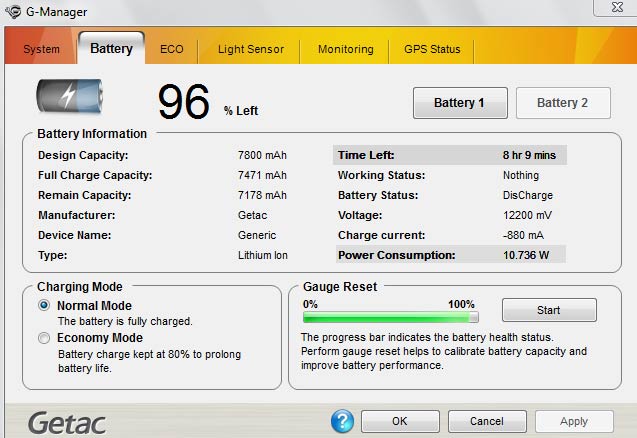
As always, real world mileage will vary. Minimum draw in a test lab is not an accurate predictor of actual battery life (we've seen standard voltage i5/i7 processors draw less than ultra-low-voltage versions). However, between the very good power management of the mobile Intel Core i5/i7 processors, Windows 7's much improved power management, and the Getac B300's extensive power management settings, if the situation requires it, the B300 can run a good long time on a charge, and twice that via an optional second battery that goes into the media bay en lieu of the optical drive. Do keep in mind, though, that power settings do affect clock speed.
QuadraClear display technology
Most rugged notebooks will be used outdoors and sometimes in bright, direct sunlight. Standard transmissive LCD displays, however, wash out in daylight, and that's why over the past few years, sunlight-readability has become a major selling point in the rugged notebook sector. RuggedPCReview's former technology editor, Geoff Walker, explained:
"There are really only two practical methods of making a notebook screen readable outdoors: (a) crank up the brightness (measured in nits, which is display-industry slang for "candela per meter squared", or cd/m2) to the point where the light emitted by the screen is sufficiently greater than the ambient light reflected by the screen, or (b) treat the surface of the screen so it reflects much less light, which again allows the emitted light to exceed the reflected light."
As a result, all major rugged notebook makers have introduced their own sunlight-viewable technologies. GD-Itronix was first in giving theirs a name (DynaVue), Panasonic named theirs CircuLumin, and Getac has QuadraClear (see brochure). The term "QuadraClear" stems from the four elements that comprise the technology: a very bright backlight, anti-reflective coatings, linear polarizer, and circular polarizer. All the major players use those technologies, and the difference boils down to a) backlight brightness and b) the extent to which the expensive optical coatings are applied and how the various layers are bonded (the fewer reflective surfaces, the better).
It's difficult to objectively quantify the impact of all those optical treatments but Walker stated that the best currently achievable compound reflectivity is about 0.9% for a touch screen display, meaning that about 0.9% of incoming ambient light is reflected. Assuming this is so, all else being equal, display backlight power then determines the all-important effective contrast ratio which then translates into the degree of real world outdoor readability.
And backlight strength is what sets the B300 apart. A standard notebook backlight is in the 170 to 200 nits luminance range (1 nit = 1 candela per square meter) range. Some manufacturers up the brightness in their rugged products, usually into the 300-400 nits range. GD-Itronix combined its initial DynaVue technology with a 500 nits backlight for excellent results. The latest Panasonic 31 has both optical coating and a very powerful 1,100 nits backlight. Getac offered the original B300 with 500 nits, but beat everyone with an optional superbright 1,200 nits backlight. And now they upped the ante with an optional industry-leading 1,400 nits backlight.
The super-bright 1,400 nits LED light is considerably brighter than the maximum of the standard brightness range. To engage it you push a special button above the keyboard. Turn it on and the screen lights up with an intensity unseen in any regular display. Having that hardware button is also the key to keeping power draw in check: when you need the superbright backlight, switch it on. When you don't need it anymore, turn it off. That's much easier with a button than via menus.
How does it all work in real life? Very well. The pictures below show different scenario comparisons between the B300 and a standard Gateway consumer notebook we use in the lab.
The first picture below shows the two machines outdoors on a bright morning. The B300 is set to use its light sensor to come up with what it considers proper backlight strength. The Gateway is set to its maximum brightness, and it's actually a good dispay that is far more readable outdoors than most consumer notebook LCDs. However, you can already see one of the B300 display's big advantages: no reflections. The B300 screen has a semi-matte surface and probably a degree of anti-glare treatment. As a result, there are no reflections whereas the Gateway screen almost looks like a mirror.

Below are the two machines in broad daylight and from an angle. The glossy Gateway display is now completely mirror-like and unusable. The B300 display still shows no reflections at all, but it turns a little milky. That's usually a combination of the diffusing effect from anti-glare treatment and the changing viewability of the LCD when viewed from an angle.
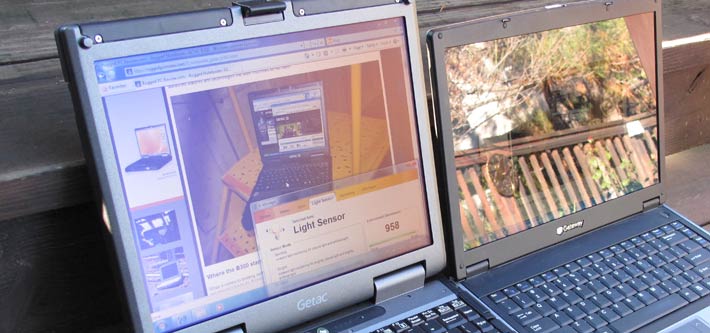
The toughest test sunlight-viewable displays must pass is when they directly face the sun. In the picture on the left, the B300's light sensor cranked up the backlight to maximum normal level. The display remains marginally readable, but is on the verge of washing out. This is where using many other notebooks claiming outdoor viewability becomes frustrating. With the B300, you simply push the high-bright button for a much brighter, clearer picture.
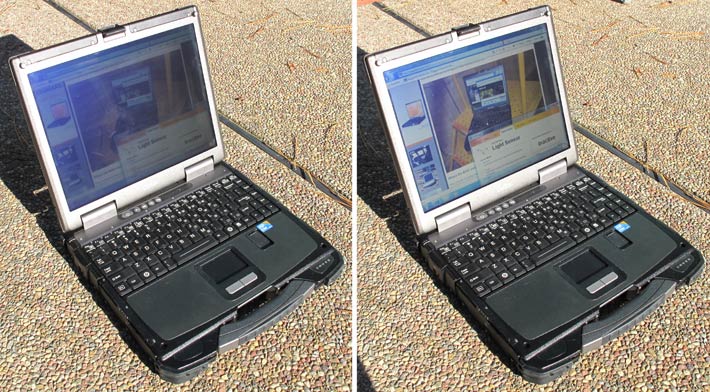
Overall, the superbright setting accessible via button push is a great idea that makes the B300 usable in situations where lesser displays wash out. Yes, it takes a lot of power to operate the display at full brightness, but that's what the on-off button is for.
A couple other comments about the display. You can adjust the backlight in 16 steps via keyboard brightness buttons, and via 64 steps in the Windows control panel. However, being able to totally turn off the backlight via a single button, and turning it to super-bright also via a single button is extremely useful. Where the display could stand improvement is in its viewing angles. The horizontal viewing angle is good enough, with just some milkiness when viewed from the side. The vertical viewing angle, however, is very narrow, with considerable chromatic aberrations as you change the angle. This used to be a common problem with TFTs, but there are now technologies that provide perfect viewing angles in all directions, and we hope Getac will consider this soon.
Wireless and expansion
As is, the Getac B300 comes with a Bluetooth Version 2.1 with EDR (Enhanced Data Rate) class 2 module and Intel Centrino Ultimate-N 6300 802.11a/b/g/n WiFi.
An integrated GPS receiver is optionally available, and for Wide Area Network communication, there is an optional Gobi 2000 module that supports just about any radio and provider worldwide.
As far as expansion goes, there is one PC Card Type II slot and one ExpressCard 34/54 slot. There are a number of options here as you can also opt for two adjacent PC Card Type II slots (or one Type III), or a PC Card slot and a Smart Card reader. There is also an SD reader that was able to read my 8GB cards and thus apparently is of the SDHC variety.
Additional expansion is possible via the B300's Media Bay. It is located on the left side of the computer. Our unit came with the Sony Optiarc rewritable drive. Depending on needs and applications, that can be replaced either with an optional second battery or an optional second hard drive.
Security
Like most mobile hardware these days, the B300 offers various levels of hardware and software security to prevent unauthorized access as well as theft.
Our system included Infineon Technologies' Infineon Security Platform Solution, a very comprehensive security setup that works in conjunction with the B300's Trusted Platform Module (TPM) 1.2 hardware to create and manage computer-generated digital certificates. Combined with software, these certificates can be used to:
- Send and receive secure email,
- Set up the browser for client identification,
- Sign Word macros,
- Encrypt individual files or entire folders, and
- Create secure network connections.
To use TPM, you have to enable TPM support in the BIOS and then configure the system.
Our test system also came with fingerprint registration software that works with the B300's fingerprint scanner.
All of this can get pretty involved. Some users may never implement TPM, fingerprint scanning or even passwords, whereas others may be set up in accordance with their company's IT security procedures, or they may configure an individual system for maximum security.
Over all this, don't forget physical security and get a Kensington locking cable to use with the Kensington slot on the backside of the unit. It is inexpensive insurance against theft.
Getac G-Panel
The new B300 comes with an updated version of the Getac G-Panel that combines a number of special utilities and helper apps that make using the unit quicker and simpler than going to the standard Windows control panels, which can be a cumbersome process.

- Summary provides a one-look summary of all major data, including battery status, CPU load and clock speed, wireless LAN signal strength, free RAM and so on. You can also drill down for more detailed and technical data.
- Battery shows % left in a large numeral, plus just about any other battery statistic you may want. It also shows the current power consumption. With the backlight at its 1,400 nits maximum, the reading was about 28 watts, with the backlight at minimum and ECO mode engaged, that dropped to 9.5 watts or so.
- ECO displays and controls power savings settings. You can customize the settings and even have certain features such as Bluetooth, WiFi or the touch screen turned off.
- Light Sensor shows you the profile chosen (normal, bright, dark). It also shows environment luminance in Lux as measured by the light sensor.
- Monitoring lets you graphically view about a dozen parameters such as CPU clock, load, voltage, temperature; free RAM, LAN stats, etc. They pop up in their own windows, and the only additional wish I'd have is being able to set the graph upper and lower limits.
- GPS Status shows satellites and summary GPS data.
Touchscreen
Our B300 came with the optional resistive touch screen that can be operated either with a supplied small telescopic stylus that sits in its own garage at the upper left of the keyboard, or with a finger.
The touch screen can be calibrated using 4, 9, or 25 points, the doubleclick area can be adjusted, and it can be set to mouse or digitizer mode. There is less functionality, though, in this utility compared to that of the original B300 that also let you map the display so that only part responded to touch, a useful feature for custom applications.
Via Windows 7, the B300 has inherent access to a wealth of pen and touch functionality. There's the hugely useful Snipping Tool, and you can use handwriting recognition via the Windows Input Panel. You can also use just about any other software designed for use with a pen, though keep in mind that resistive touch does not sense the pen floating above the display like an active dgitizer does. Also, ink doesn't go on as smoothly in recognition mode.
Ruggedness
The Getac B300 is a rugged computer capable of absorbing rough handling and demanding environmental conditions. The magnesium-alloy housing with its protective rubber bumpers on all four corners on top, large rubber bumpers at the bottom front and smaller bumpers at the bottom rear protect the unit from casual damage. The thick (and easily replaceable) bumpers on top not only provide excellent impact protection, but also keep the machine from getting scratched.
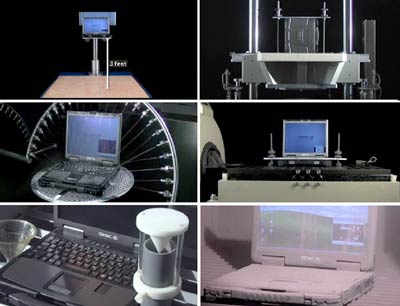 As for environmental specs, the B300 has an operating temperature range of -4 to 140 degrees Fahrenheit, making it suitable for use in virtually any operating environment from freezers to desert. As for environmental specs, the B300 has an operating temperature range of -4 to 140 degrees Fahrenheit, making it suitable for use in virtually any operating environment from freezers to desert.
In terms of listed ruggedness testing results, Getac's documentation is sparse, simply stating that the unit is MIL-STD 810G and IP65 compliant, and can be ordered with optional compliance for UL1604 Class 1 Div. 2 (Groups A-D), salt fog exposure, MIL-STD 461F (electromagnetic interference) and MIL-STD 3009 Night Vision.
The pictures on the right are screen snaps from Getac's ruggedness demonstration videos (see here). While the videos are impressive and real, we would like to see more detailed specs listed, and the supporting documentation available on the website.
As far as sealing goes, the new B300 carries an IP65 rating, as opposed to the original version's IP54. The "6" here means that the unit is now totally protected against dust, with no amount allowed; and the "5" means that it is protected against low pressure water jets from all directions, and not just water spray. Limited ingress permitted, though.
We do have some reservations about the port sealing technology, which depends entirely on exterior protective doors. There is no additional sealing that keeps dust and moisture out should the seal of a protective door fail, or the user forget to properly close and secure a door. Sealing all I/O openings in the housing with silicone glue or similar would provide a second barrier. We also feel that the various types of locks and levers used should be re-examined for smoother operation and tighter fit.
Overall, ruggedness specs remain a somewhat ambiguous area. The almost universally cited MIL-STD-810F and G were meant to be used for "tailoring a materiel item's environmental design and test limits to the conditions that the specific materiel will experience throughout its service life, and establishing laboratory test methods that replicate the effects of environments on materiel," but those tests were not specifically designed to examine notebook computer ruggedness.
Bottom line
The latest version of the Getac B300—one of the primary contenders in the full-size rugged notebook market—has received a major technology update. Now with Intel Core i7 power, this well-conceived, well-executed design is both pleasing to the eye and able to withstand the punishment of hard use in the field. Despite its inherent ruggedness, the B300 is fairly compact and weighs only about 8.5 pounds.
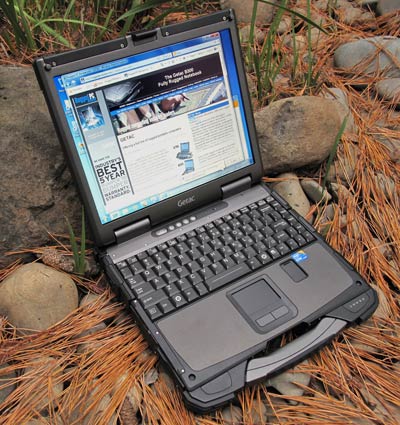 Even with the significantly more powerful 2.0 GHz Core i7-620LM processor, the B300 still does not need a fan, runs in complete silence, and, thanks to an elaborate heat piping system, doesn't even warm up much. Other technology updates include more standard and maximum RAM (2GB and 8GB, respectively, and of the faster DDR3 variety), larger disks, the availability of solid state storage, an HDMI port, updated Bluetooth and WiFi, and optional Gobi 2000 WWAN for wireless technology and carrier independence. Even with the significantly more powerful 2.0 GHz Core i7-620LM processor, the B300 still does not need a fan, runs in complete silence, and, thanks to an elaborate heat piping system, doesn't even warm up much. Other technology updates include more standard and maximum RAM (2GB and 8GB, respectively, and of the faster DDR3 variety), larger disks, the availability of solid state storage, an HDMI port, updated Bluetooth and WiFi, and optional Gobi 2000 WWAN for wireless technology and carrier independence.
Battery life is down a bit, but thanks to Getac's ECO mode settings, we still saw as much as eight hours. That is "highway mileage," of course, and battery life will be less under heavy use. There's a media bay that can accommodate a second battery of equal capacity. The already substantial ruggedness of the original design has been enhanced with a wider operating temperature range (now -4 to 140F) and even better sealing (IP65 instead of IP54).
A stunning feature of the B300 is the incredibly strong backlight of its 13.3-inch display. In normal use it's just a standard transmissive LCD with some coatings that provides a good degree of outdoor viewability. But turn on the super-intense 1,400 nits backlight via pushbutton and the display is brighter than any other we've seen. It takes a toll on battery life, of course, but the good thing is that you can turn it on and off as needed via push button.
Overall, the Getac B300 is a superb, powerful, and very cleverly designed rugged machine that's well equipped to take on the competition. The latest version is also fully backward compatible with all earlier B300 peripherals
-- Conrad H. Blickenstorfer
|
Getac B300 Specifications
|
| Type |
Rugged notebook
|
| Introduced |
September 2010, as update to existing B300
|
| Processor |
Intel Core i7 620LM with 4MB L3 cache
|
| CPU speed |
2.0GHz (2.80GHz with Turbo Boost)
|
| Thermal Design Power |
25 watts
|
| Chipset |
Intel QM57
|
| Graphics |
Intel Graphics Media Accelerator HD
|
| Display Chipset |
Integrated into processor |
| OS |
Windows 7 Professional
|
| Memory |
2GB/8GMB DDR3 800/1066MHz |
| Display |
13.3-inch/1024x768 pixel sunlight-readable TFT with 700 nits backlight. Optional: 1400 nits sunlight-readable "QuadraClear" display with optional night vision feature |
| Digitizer |
Touch screen (opt.) |
| Keyboard |
Integrated, full-scale with waterproof backlit mechanical membrane; optional backlit waterproof rubber keyboard |
| Storage |
Shock-mounted SATA 250GB HDD (5400 rpm Toshiba MK2565GSX); optional 80 or 160GB SSD
|
| Expansion slots |
1 PC Card Type II and either 1 Express Card 34/54mm, 1 Smart Card reader, or a second PC Card Type II; SD Card, 1 SIM
|
| Housing |
Magnesium alloy, sealed ports |
| Size |
11.9 x 10.35 x 2.36 |
| Weight |
8.6 lbs. as tested, with battery, handle and optical drive
|
| Operating temperature |
-4 to 140 F |
| Ingress protection |
IP65 |
| Drop/shock/other |
MIL-STD-810G; optional: MIL-STD 461E, salt fog compliance |
| Power |
Li-Ion (11.1V, 7,800mAh, 87 watt-hours); optional media bay battery (7,800mAh) ("up to 11/22 hours") |
| Interface |
2 USB 2.0, RJ11, gigabit RJ45, 2 Serial, dock, 1394a, audio in/out, video (VGA and HDMI), fingerprint scanner |
| Wireless options |
Intel Centrino Ultimate-N 6300; Bluetooth 2.1 + EDR Class II, optional 3G Gobi EV-DO, GPRS/EDGE, UMTS, WCDMA, HSDPA; optional GPS
|
| Price |
Starting at high US$3,000s |
| Contact |
GETAC us.getac.com |
| Warranty |
5-year bumper-to-bumper |
(copyright 2011 RuggedPCReview.com)
|
|



